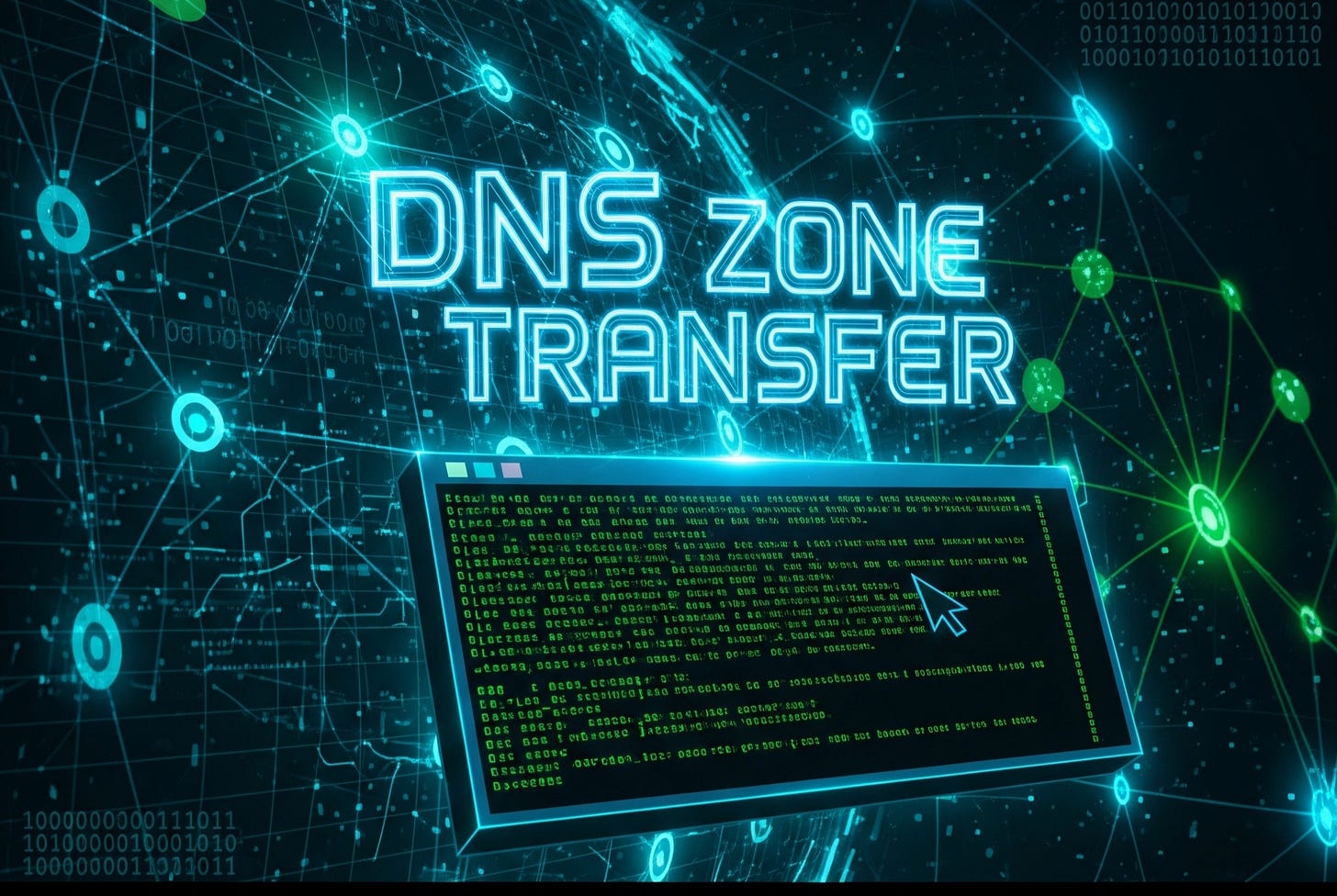🔎 DNS Zone Transfer – Your Gateway to Recon Goldmine 👨💻 By 𝟎𝒙𝒎𝒖𝒏𝟏𝒓 | 𝐄𝐭𝐡𝐢𝐜𝐚𝐥 𝐇𝐚𝐜𝐤𝐢𝐧𝐠 𝐈𝐧 𝐀𝐜𝐭𝐢𝐨𝐧
A bug hunter doesn't just report "DNS Zone Transfer is possible." They think about the attack chain: "What information did this vulnerability give me, and what can I do with it to find a bigger bug?" The process can be broken down into two main phases:
Enumeration: This is the detailed process of gathering and analyzing the information disclosed by the zone transfer.
Exploitation: This isn't just one action. It's using the enumerated information to find and exploit secondary vulnerabilities that were hidden before.
Phase 1: Detailed Enumeration of the Zone File
A successful dig axfr command can dump a massive amount of data. Your job is to be a detective and analyze every line. Here's what you're looking for, with a more detailed explanation for each record type.
Hypothetical Zone Transfer Output:
example.com. 3600 IN A 172.16.0.1www.example.com. 3600 IN A 172.16.0.1mail.example.com. 3600 IN MX 10 smtp.example.com.smtp.example.com. 3600 IN A 172.16.0.10dev-staging.example.com. 3600 IN A 172.16.1.50jira-internal.example.com. 3600 IN A 172.16.2.100test-server.example.com. 3600 IN A 172.16.2.150api-v2-dev.example.com. 3600 IN A 172.16.3.20vpn-gateway.example.com. 3600 IN A 172.16.4.1Analysis and Prioritization:
Internal vs. External IP Addresses: Notice the IP addresses starting with 172.16. These are private IP ranges, meaning these services might only be accessible from within the company's network. Finding these is a high-impact discovery because it reveals internal infrastructure that was meant to be completely hidden.
Keywords: Look for keywords in the hostnames that reveal the purpose of a server:
dev or staging: Servers like dev-staging.example.com are gold mines. They are often unpatched, run older software, or have weaker security controls because they are not meant for public access. This is a prime target for a deeper reconnaissance.
test: A server like test-server.example.com is another great target. It might contain test accounts, default credentials, or vulnerable, experimental code.
internal: Servers like jira-internal.example.com are explicitly named as private services. This is a very strong indicator of information disclosure and could lead to vulnerabilities like a login page with default credentials or other misconfigurations.
vpn or gateway: A server like vpn-gateway.example.com is a critical piece of infrastructure. If you can find a way to access this, you might be able to get inside the company network.
Phase 2: The Bug Hunter's "Exploitation"
In bug bounty, "exploitation" of a zone transfer means leveraging the discovered information to find other bugs. The zone transfer itself is the initial vulnerability (information disclosure), which you'll report. The secondary exploitation is the real prize.
Here is a step-by-step example of how a bug hunter would proceed:
Initial Finding: You successfully performed a zone transfer on example.com. This is a low-to-medium severity finding on its own.
Target Prioritization: You scan the zone file and identify dev-staging.example.com as a high-value target because of its name. You also find its IP address, 172.16.1.50.
Secondary Reconnaissance:
Port Scanning: You run a port scan on 172.16.1.50 to see what services are running. You find that port 8080 (commonly used for web servers like Jenkins or Tomcat) is open. This is new information that was not available from the public-facing site.
Service Enumeration: You check the service running on port 8080 and find it's a Jenkins server.
Vulnerability Search: You then check for publicly known exploits for that version of Jenkins. You also try default passwords like admin:admin or jenkins:jenkins, which are common on development servers.
Finding the Real Bug: You try admin:admin and find that it works! You now have administrative access to the company's Jenkins server.
Crafting the Report: Your final report is no longer just about a DNS zone transfer. It is a critical-severity report with a multi-step attack chain:
Title: "Critical RCE via Jenkins Server with Default Credentials, Discovered via Unrestricted DNS Zone Transfer"
Description: You start by explaining the DNS zone transfer vulnerability.
Proof of Concept (PoC): You detail Step 1 (the dig command) to show how you found the dev-staging server.
Impact: You explain that this disclosure led you to an internal Jenkins server running on a non-obvious subdomain.
Secondary PoC: You then provide the steps and a screenshot showing that you were able to log in with default credentials on the newly discovered server.
Severity: You argue that the root cause (the zone transfer) enabled a more severe vulnerability (RCE or administrative access on a private server), warranting a much higher reward.
This is the true art of a bug hunter: chaining multiple small findings together to prove a massive security impact. The DNS zone transfer wasn't the final bug; it was the key that unlocked the real one.




